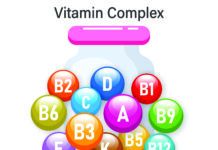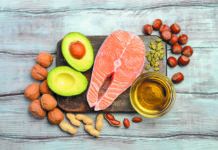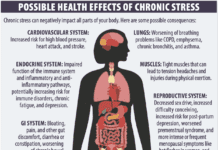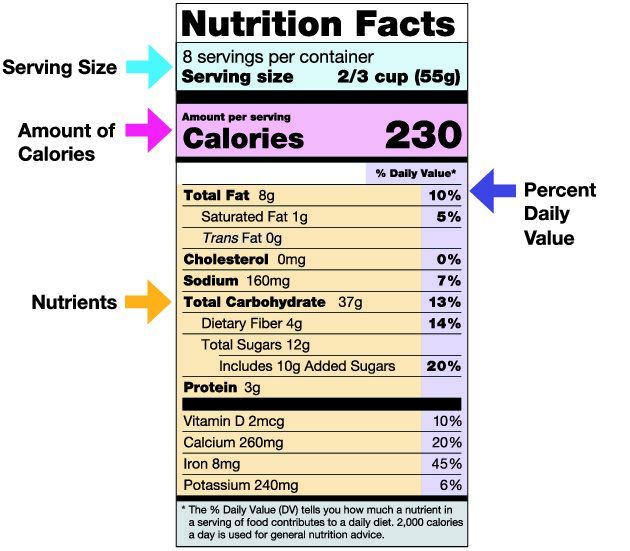In today’s world, it’s practically impossible to avoid all packaged foods. Knowing how to decipher the clues on packages can help you find the healthiest choices.
Nutrition Facts Labels. The federally mandated Nutrition Facts label on the back or side of a food package is specifically designed to help you identify healthier choices. For each “serving” of a food, the label is required to provide information on calories, macronutrients (fats, carbohydrates, and protein), and nutrients of public health concern (sodium, dietary fiber, added sugars, potassium, calcium, vitamin D, and iron). In addition to the number of grams or micrograms of each nutrient, there is a “% Daily Value” or DV. This percentage helps you see how a product fits into your overall dietary pattern. It is based on a 2,000-calorie diet.
To make the best use of the Nutrition Facts label:
1. Start by looking at the number of “servings per container” and the “serving size” at the top. All of the numbers in the chart apply to that serving size. If you eat more than that amount, you will be getting more of all the calories and nutrients in that product. Serving sizes are designed to reflect what people actually eat and drink. This is not the same as a recommended serving for healthy dietary intake.
2. Keep in mind that you are trying to stay under 100 percent daily value (DV) of saturated fat, sodium, and added sugars over the day. (Note that the DV for sodium is 2,300 milligrams a day.)
3. Remember that dietary fiber, vitamin D, calcium, iron, and potassium are desirable, as many Americans do not get enough of these nutrients.
4. Use the Nutrition Facts panel to compare products within the same category. For example, compare labels on crackers to choose those with more fiber and less sodium.
Ingredients Lists. A list of ingredients is also required by federal law. Each ingredient in a product must be listed in descending order by weight. This means the ingredient that weighs the most is listed first, and the ingredient that weighs the least is listed last. “This is not always as straightforward as it sounds,” says Alice H. Lichtenstein, DSc, Stanley N. Gershoff professor of nutrition at the Friedman School and editor-in-chief of this newsletter. “A product may list whole wheat flour first, but if this is followed by several different added sugars (such as brown rice syrup, fruit juice concentrate, corn syrup, dextrose, and fructose) the product may actually be mostly sugar!”
If most of the ingredient list is made up of words you don’t recognize, the food is likely ultraprocessed and is not the best choice.
For grain-based foods, the healthiest choices are whole grain. The first or second ingredient on the list should say “whole.”
Front of Package Symbols. The Nutrition Facts label and ingredients list are tucked away on the back or side of a package. The first thing we see are the words and symbols splashed across the front of the package. Some of these words have a specific meaning—and some do not. For definitions of front-of-package claims regulated by the U.S. Food and Drug Administration, see the “What Does it Mean?” chart. For claims to be wary of, see the “False Friends?” box.
No matter what the front of the package says, to make the best choices it still pays to check out the Nutrient Fact label and ingredient list.

Schemes and Stamps. The use of front-of-package nutrition labeling schemes has increased dramatically around the world in recent years. These schemes—which include things like red/green/yellow “traffic light” colors, nutrition “grades” (A through E), warning symbols, and star rating systems, are designed to help consumers identify healthier foods. Researchers are exploring the effectiveness of these different schemes, and the FDA is currently exploring the development of a standardized front-of-package nutrition labeling scheme that would be used on all food sold in the U.S.

Among all the other front-of-package words and images, you may see various third-party stamps or shields. With the notable exception of the “USDA Organic” stamp, most of these are voluntary programs offered to food manufacturers (usually for a small fee) by not-for-profit organizations. For example, the American Heart Association’s Heart Check food certification program allows its stamp to be printed on foods that meet specific, science-based criteria for promoting heart health.

Likewise, the Whole Grains Council whole grain stamp is designed to help consumers find foods that provide a significant amount of whole grain. It’s important to keep in mind that not all food manufacturers participate in these programs, so the absence of such a stamp does not mean the product fails to meet the criteria.
➧ Flip it Over. The Nutrition Facts panel and ingredients list provide valuable information.
➧ See How It compares. Use the “% Daily Value” on the Nutrition Facts panel to find foods with lower saturated fat, sodium, or added sugar and more dietary fiber, vitamin D, potassium, calcium, and iron.
➧ Understand Front-of-Package Claims. Words like “high,” “low,” and “reduced” are defined by law. It helps to know what they mean.
➧ Beware of False Friends. Foods marked “organic,” “natural,” “gluten-free,” or “multigrain” can be just as processed and unhealthy as other packaged foods.























